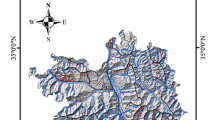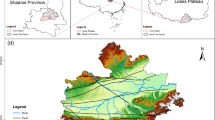Abstract
The aim of this study was to compare the performance of the Analytical Hierarchy Process (AHP) and Certain Factor (CF) models in landslide susceptibility mapping (LSM) in the western province of Rwanda. At first, landslide inventory map was prepared using 96 points localized by field surveying. Then, 65.63% (63 of 96 landslides) were randomly selected for building landslide susceptibility and the remaining 34.37% (33 of 96 landslides) were used to validate the models. Eight conditioning factors: elevation, slope angles, distance to roads, land use and land cover, rainfall, lithology, soil texture, and normalized difference vegetation index were analysed. The produced susceptibility maps were zoned into very low, low, moderate, high, and very high susceptibility. The validation of landslides susceptibility maps was accomplished by the area under the curve (AUC) method. The CF model generated high accuracy and prediction rates (74.62 and 74.012%) than that of AHP model (73.063 and 73.83%), respectively. The produced landslide susceptibility maps can help to recognize landslide hazard mitigation and adaptation needs.






Similar content being viewed by others
References
AbdelRahman MA, Shalaby A, Essa E (2018) Quantitative land evaluation based on fuzzy-multi-criteria spatial model for sustainable land-use planning. Model Earth Syst Environ 1–13
Banerjee P, Ghose MK, Pradhan R (2018) Analytic hierarchy process and information value method-based landslide susceptibility mapping and vehicle vulnerability assessment along a highway in Sikkim Himalaya. Arab J Geosci 11(7):139
Chen W, Li W, Chai H, Hou E, Li X, Ding X (2016) GIS-based landslide susceptibility mapping using analytical hierarchy process (AHP) and certainty factor (CF) models for the Baozhong region of Baoji City, China. Environ Earth Sci 75(1):63
Chuang Y-C, Shiu Y-S (2018) Relationship between landslides and mountain development—integrating geospatial statistics and a new long-term database. Sci Total Environ 622:1265–1276
Cui K, Lu D, Li W (2017) Comparison of landslide susceptibility mapping based on statistical index, certainty factors, weights of evidence and evidential belief function models. Geocarto Int 32(9):935–955
Dawson N, Martin A (2015) Assessing the contribution of ecosystem services to human wellbeing: a disaggregated study in western Rwanda. Ecol Econ 117:62–72
Devkota KC, Regmi AD, Pourghasemi HR, Yoshida K, Pradhan B, Ryu IC, Dhital MR, Althuwaynee OF (2013) Landslide susceptibility mapping using certainty factor, index of entropy and logistic regression models in GIS and their comparison at Mugling–Narayanghat road section in Nepal Himalaya. Nat Hazards 65(1):135–165
Dou J, Bui DT, Yunus AP, Jia K, Song X, Revhaug I, Xia H, Zhu Z (2015) Optimization of causative factors for landslide susceptibility evaluation using remote sensing and GIS data in parts of Niigata, Japan. PLoS One 10(7):e0133262
Fan W, Wei X-s, Cao Y-b, Zheng B (2017) Landslide susceptibility assessment using the certainty factor and analytic hierarchy process. J Mt Sci 14(5):906–925
Fan X, Zhan W, Dong X, van Westen C, Xu Q, Dai L, Yang Q, Huang R, Havenith H-B (2018) Analyzing successive landslide dam formation by different triggering mechanisms: The case of the Tangjiawan landslide, Sichuan, China. Eng Geol 243:128–144
Göransson G, Norrman J, Larson M (2018) Contaminated landslide runout deposits in rivers–Method for estimating long-term ecological risks. Sci Total Environ 642:553–566
Hong H, Pourghasemi HR, Pourtaghi ZS (2016) Landslide susceptibility assessment in Lianhua County (China): a comparison between a random forest data mining technique and bivariate and multivariate statistical models. Geomorphology 259:105–118
Ibrahim YZ, Balzter H, Kaduk J, Tucker CJ (2015) Land degradation assessment using residual trend analysis of GIMMS NDVI3g, soil moisture and rainfall in Sub-Saharan West Africa from 1982 to 2012. Remote Sens 7(5):5471–5494
Kannan M, Saranathan E, Anabalagan R (2013) Landslide vulnerability mapping using frequency ratio model: a geospatial approach in Bodi-Bodimettu Ghat section, Theni district, Tamil Nadu, India. Arab J Geosci 6(8):2901–2913
Karamage F, Zhang C, Kayiranga A, Shao H, Fang X, Ndayisaba F, Nahayo L, Mupenzi C, Tian G (2016) Usle-based assessment of soil erosion by water in the Nyabarongo River Catchment, Rwanda. Int J Environ Res Public Health 13(8):835
Kim D, Im S, Lee SH, Hong Y, Cha K-S (2010) Predicting the rainfall-triggered landslides in a forested mountain region using TRIGRS model. J Mt Sci 7(1):83–91
Kim HG, Lee DK, Park C, Ahn Y, Kil S-H, Sung S, Biging GS (2018) Estimating landslide susceptibility areas considering the uncertainty inherent in modeling methods. Stoch Environ Res Risk Assess 32(11):2987–3019
Li C, Tang H, Ge Y, Hu X, Wang L (2014) Application of back-propagation neural network on bank destruction forecasting for accumulative landslides in the three Gorges Reservoir Region, China. Environ Res Risk Assess 28(6):1465–1477
Moeyersons J (2003) The topographic thresholds of hillslope incisions in southwestern Rwanda. Catena 50(2–4):381–400
Nsengiyumva JB, Luo G, Nahayo L, Huang X, Cai P (2018) Landslide susceptibility assessment using spatial multi-criteria evaluation model in Rwanda. Int J Environ Res Public Health 15(2):243
Poli S, Sterlacchini S (2007) Landslide representation strategies in susceptibility studies using weights-of-evidence modeling technique. Nat Resour Res 16(2):121–134
Pradhan B, Lee S (2010) Delineation of landslide hazard areas on Penang Island, Malaysia, by using frequency ratio, logistic regression, and artificial neural network models. Environ Earth Sci 60(5):1037–1054
RMA (2018) Rwanda Meteorological Agency, Meteo Rwanda Map Room, Climate Data Library
Rushemuka PN, Bock L, Mowo JG (2014) Soil science and agricultural development in Rwanda: state of the art. A review. BASE
Saaty TL (1980) The analytic hierarchy process: planning, priority setting, resources allocation. McGraw, New York, p 281
Sar N, Chatterjee S, Adhikari MD (2015) Integrated remote sensing and GIS based spatial modelling through analytical hierarchy process (AHP) for water logging hazard, vulnerability and risk assessment in Keleghai river basin, India. Model Earth Syst Environ 1(4):31
Sharma L, Patel N, Ghose M, Debnath P (2014) Application of frequency ratio and likelihood ratio model for geo-spatial modelling of landslide hazard vulnerability assessment and zonation: a case study from the Sikkim Himalayas in India. Geocarto Int 29(2):128–146
Shortliffe EH, Buchanan BG (1975) A model of inexact reasoning in medicine. Math Biosci 23(3–4):351–379
Tian Y, Xu C, Chen J, Hong H (2017) Spatial distribution and susceptibility analyses of pre-earthquake and coseismic landslides related to the Ms 6.5 earthquake of 2014 in Ludian, Yunan, China. Geocarto Int 32(9):978–989
USGS (2018) United States Geological Survey, Science for a changing world. https://earthexplorer.usgs.gov/. Accessed July 2017
Van Westen CJ, Castellanos E, Kuriakose SL (2008) Spatial data for landslide susceptibility, hazard, and vulnerability assessment: an overview. Eng Geol 102(3–4):112–131
Wagesho N, Claire M (2016) Analysis of rainfall intensity–duration-frequency relationship for Rwanda. J Water Resour Protect 8(07):706
Wang X, Wang S, Ren L, Zeng Z (2017) Spatial distribution of rainstorm hazard risk based on EW-AHP in mountainous scenic area of China. Human Ecol Risk Assess Int J 23(4):925–943
Xu C, Xu X, Dai F, Xiao J, Tan X, Yuan R (2012) Landslide hazard mapping using GIS and weight of evidence model in Qingshui river watershed of 2008 Wenchuan earthquake struck region. J Earth Sci 23(1):97–120
Yiping W, Cong C, Gaofeng H, Qiuxia Z (2014) Landslide stability analysis based on random-fuzzy reliability: taking Liangshuijing landslide as a case. Stoch Environ Res Risk Assess 28(7):1723–1732
Yue X-l, Wu S-h, Huang M, Gao J-b, Yin Y-h, A.-q. Feng, and X.-p. Gu. 2018. Spatial association between landslides and environmental factors over Guizhou Karst Plateau, China. J Mt Sci 15 (9):1987–2000
Zhu Z, Xie J, Zhang J, Liang H, Qiu Y, Xia Z, Ling Q, Lin J, Zhou H (2007) Characteristics of geological hazards in South China coastal areas and impact on regional sustainable development. Int J Sustain Dev World Ecol 14(4):421–427
Zuo R, Carranza EJM (2017) A fractal measure of spatial association between landslides and conditioning factors. J Earth Sci 28(4):588–594
http://meteorwanda.gov.rw/maproom. Accessed April 05, 2018
Acknowledgements
The authors greatly thank the University of Chinese Academy of Sciences for this Ph.D. scholarship awarded. Authors are also grateful for the support in data collection and analysis from the CAS Research Centre for Ecology and Environment of Central Asia.
Author information
Authors and Affiliations
Corresponding author
Ethics declarations
Conflict of interest
All authors declare no conflicts of interest.
Additional information
Publisher’s Note
Springer Nature remains neutral with regard to jurisdictional claims in published maps and institutional affiliations.
Rights and permissions
About this article
Cite this article
Nahayo, L., Kalisa, E., Maniragaba, A. et al. Comparison of analytical hierarchy process and certain factor models in landslide susceptibility mapping in Rwanda. Model. Earth Syst. Environ. 5, 885–895 (2019). https://doi.org/10.1007/s40808-019-00575-1
Received:
Accepted:
Published:
Issue Date:
DOI: https://doi.org/10.1007/s40808-019-00575-1




